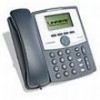Linksys SPA922 Cisco SPA9000 Voice System Administration Guide - Page 281
Enhanced service-Services that are provided in addition to basic long distance
 |
UPC - 745883570836
View all Linksys SPA922 manuals
Add to My Manuals
Save this manual to your list of manuals |
Page 281 highlights
Glossary E Circuits-The communication path(s) that carry calls between two points on a network. Customer Premise Equipment-The only part of the telecommunications system that the customer comes into direct contact with. Example of such pieces of equipment are telephones, key systems, PBXs, voice-mail systems, and call accounting systems as well as wiring telephone jacks. The standard for this equipment is set by the FCC, and the equipment is supplied by an interconnect company. Dedicated access-Customers have direct access to the long-distance provider via a special circuit (T1 or private lines). The circuit is hardwired from the customer site to the POP and does not pass through the LEC switch. The dial tone is provided from the long-distance carrier. Dedicated Access Line (DAL)-Provided by the local exchange carrier. An access line from the customer's telephone equipment directly to the long-distance company's switch or POP. Demarcation point-This is where the LEC ownership and responsibility (wiring, equipment) ends and the customer's responsibilities begin. Direct Inward Dialing (DID)-Allows an incoming call to bypass the attendant and ring directly to an extension. Available on most PBX systems and a feature of Centrex service. Dual Tone Multifrequency (DTMF)-Better known as the push button keypad. DTMF replaces dial pulses with electronically produced tones for network signaling. Enhanced service-Services that are provided in addition to basic long distance and accessed by way of a touchtone phone through a series of menus. Exchange code (NXX)-The first three digits of a phone number. Flat-rate pricing-The customer is charged one rate (sometimes two rates, one for peak and one for off-peak) rather than a mileage-sensitive program rate. IXC (Interexchange Carrier)-A long-distance provider that maintains its own switching equipment. IVR (Interactive Voice Response)-Provides a mechanism for information to be stored and retrieved using voice and a touchtone telephone. Local loop-The local telephone company provides the transmission facility from the customer to the telephone company's office, which is engineered to carry voice and/or data. SPA9000 Voice System Administration Guide 279















